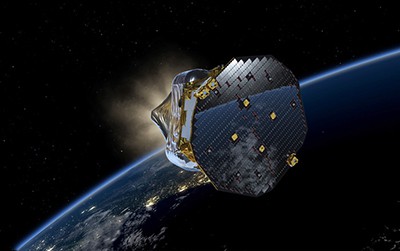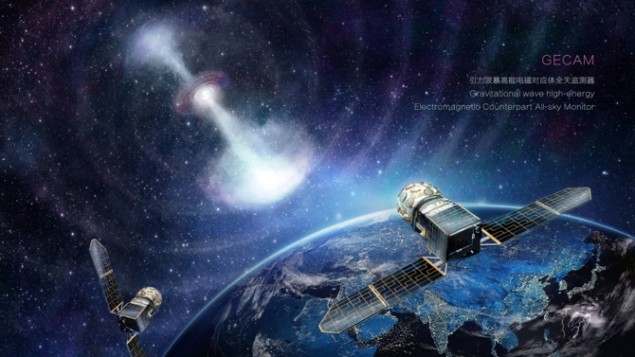China unveils plans for two new gravitational-wave missions
11 Jul 2018
China has revealed plans for two space-based missions to study gravitational waves. The National Space Science Center, Chinese Academy of Sciences (CAS), announced on 4 July that the country will launch a mission in 2020 to monitor gamma-ray bursts associated with gravitational-wave events. The CAS also gave the go-ahead for a fully-fledged gravitational-wave detector to be sent into space in 2033.
Gravitational waves are distortions of space–time that occur when massive bodies, such as black holes, are accelerated. Since their first direct detection in 2015 by the Laser Interferometer Gravitational-Wave Observatory (LIGO) detectors in Washington and Louisiana, scientists have since picked up several other events from the merger of black holes as well as neutron stars.
While scientists have the capability to detect such events, pinpointing their exact location is difficult with ground-based gravitational-wave detectors. This can be improved, however, by follow-up observations from ground- and space-based telescopes operating at various wavelengths. Gamma rays, for example, can play a unique role in this effort. During the merger of two neutron stars, a gamma-ray burst usually happens right after the generation of gravitational waves and before X-ray, optical and radio wavelengths can be detected.
Collaboration between China and Europe in space-based gravitational wave science is absolutely neededKarsten Danzmann
“It’s like when you hear a thunderstorm, you look for lightning somewhere in the sky,” says Shaolin Xiong, a high-energy astrophysicist from the Institute of High Energy Physics in Beijing. “The lightning shows where the thunder is coming from”. Similarly, if scientists can associate a detected gamma-ray burst to a gravitational-wave event, they will be able to tell specifically which part of the sky it is happening and carry-out follow-up observations at other wavelengths.
Xiong is principal investigator for a new mission that will consist of two probes placed at opposite sides of the Earth to detect gamma-ray bursts in the energy range of 8 keV – 2 MeV. Dubbed the Gravitational wave high-energy Electromagnetic Counterpart All-sky Monitor (GECAM), it is now going through “phase A” study but the technical readiness for the mission is “high” according to Xiong. Once launched, the craft should begin operation in the second half of 2020, just when LIGO reaches its design sensitivity.
Space-based detection
A mission to directly detect gravitational-waves from space was also given the green light for further development by CAS. Low-frequency gravitational waves are inaccessible on Earth because ground-based interferometers would be required to have impossibly long arms. A space-based mission, however, could pick up gravitational-waves with frequencies between 10–4-10–1 Hz from, for example, the coalescence of supermassive black holes.

Dubbed TAIJI, the craft would detect gravitational waves from the merger of black holes and adopt a similar mission concept and technology with the European Space Agency’s LISA probe, which will launch around 2034 and consist of three spacecraft separated by 2.5 million km in a triangular formation, following Earth in its orbit around the Sun.
Like LISA, TAIJI would also place three craft in a triangular configuration in a sun-synchronous orbit with each side of the triangle instead being three million kilometers long. It will operate at a frequency range 0.01-1 Hz, and will focus on intermediate mass black-hole binaries.READ MORE

TAIJI’s budget has not been revealed but it is considered to be at least 15 billion yuan ($2.26bn). China aims to first launch a “pathfinder” demonstrator craft around 2025 to test the technology behind TAIJI. “We’ve got good technology reserves and talent teams, and we are pushing forward at full speed to meet the timeline,” says Yueliang Wu, a theoretical physicist from the University of the Chinese Academy of Sciences who is TAIJI’s principal investigator.
China was invited to join LISA but its role was limited after NASA returned to the mission. While the community in China then decided to develop their own probe, it won’t stop researchers from the country working with their Europe counterparts. “Collaboration between China and Europe in space-based gravitational wave science is absolutely needed,” says Karsten Danzmann from the Max Planck Institute for Gravitational Physics in Hannover, who is also chair of the LISA consortium. “We’ll be happy to help with TAIJI pathfinder, for instance by organizing workshops in Europe.”
Ling Xin is a freelance writer based in Beijing
1/10/2018 from physicsworld.com

Δεν υπάρχουν σχόλια:
Δημοσίευση σχολίου